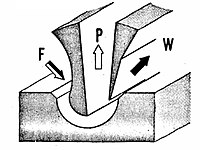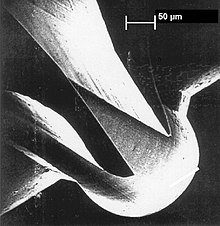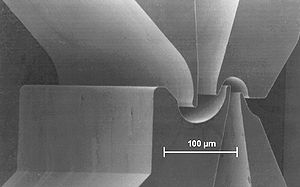Separation nozzle process
The separation nozzle process for uranium enrichment (enrichment of the light uranium isotope 235 U) was carried out until the end of the 1980s in what was then the Karlsruhe Nuclear Research Center (now Karlsruhe Research Center, now Karlsruhe Institute of Technology , North Campus) in the Institute for Nuclear Process Engineering (now Institute for Microstructure Technology) under the direction of Erwin Willy Becker developed.
In order to realize an industrial application, the nuclear research center worked closely with German industry. While the separation nozzle process was not used on a large scale due to excessive energy consumption, the development work for the production of the very small separation nozzles (see below) was used elsewhere in microsystem technology: They expanded the available range of materials and enabled the production of microstructures with great heights or Aspect ratios . These new microfabrication technologies - so-called “mechanical microfabrication” and the LIGA process - are widely used today. For the industrial application of the LIGA process, the nuclear research center began a cooperation with Steag AG, Essen, at an early stage . This cooperation was the basis for the foundation of the company microParts, Dortmund . Steag microParts GmbH was acquired by Boehringer Ingelheim in 2004 and now operates under the name Boehringer Ingelheim microParts GmbH .
The success of the microsystem technology manufacturing technologies developed within the scope of the separation nozzle process makes it sensible to take a more detailed look at this enrichment process today. As part of the development of the separation nozzle process, the micromechanics, which was dominated by silicon technology at the time, was expanded to include new materials, and microstructures made of plastics, metals and later also ceramics were produced.
It was not the separation nozzle process that was used in the Y-plant enrichment plant in Velindaba for the production of highly enriched uranium , from which South Africa produced some usable nuclear weapons after 1978, but another, likewise gas-dynamic process, which can be referred to as the "vortex tube process", as from the cited publication can be clearly seen. A three-dimensional flow is generated in a vortex tube, while the flow is only two-dimensional in the separation nozzle process (see principle). The principle of a vortex tube and a comparison with a separation nozzle was in the 1978 Journal of Natural Research A published.
principle
A mixture of uranium hexafluoride (UF 6 ) and a slight additional gas (helium or hydrogen) flows through a slot-shaped nozzle with curved walls due to a pressure gradient. At the end of the diversion, the output flow (F = feed) is divided into a light fraction (P = product) and a heavy fraction (W = waste) using a wedge-shaped peeler. Due to the mass dependence of the centrifugal forces, the heavy uranium isotopes migrate preferentially to the baffle and the light uranium isotope thus accumulates in the light fraction (P). The light additional gas causes an increase in the isotope segregation essentially by increasing the gas velocity and the associated centrifugal forces.
Separation stages and cascade
Depending on the operating conditions, separation factors between 1.015 and 1.025 are achieved. This means that you have to connect several hundred stages in a cascade in order to achieve the enrichment level of 235 U required for light water reactors . However, the isolating stages can be built so large that no parallel connection of stages is necessary. For this purpose, stages with volume throughputs of 33,000, 100,000 and 300,000 m³ / h were developed. In such a separation stage, the gas is compressed by a factor of two to four using a compressor, the compression heat is dissipated in a cooler, and then the gas is pressed through the separation nozzles. The expanded gas streams are then directed to other stages of the cascade. The picture shows an open separating stage with a volume throughput of 100,000 m³ / h when the last separating nozzle tube is retracted. The stages of the separation nozzle process are structured similarly to the stages in the gas diffusion process .
The slot length of the separation nozzles in a stage depends, as expected, on the volume throughput of the stages, but also on their operating pressure (or the width of the separation nozzle slots, see below). One kilometer per step can be given as a rough guide. The total slot length of an enrichment cascade would therefore far exceed 100 km.
Since no stages are connected in parallel in a separating nozzle cascade, it would be difficult and tedious to generate the high enrichment required for atomic bombs with a system that is designed for the degree of enrichment required for nuclear reactors (about 3% 235 U). H. a separating nozzle cascade would have a relatively high security against proliferation . Such abuse would also be easily detectable through inspections. In contrast to the separating nozzle process (or also to the diffusion process), a few stages are connected in series in an enrichment cascade with gas centrifuges (the process most commonly used today), but many stages in parallel. This is due to the very high separation factors and the comparatively low throughput of gas centrifuges. Therefore, a centrifuge system designed for nuclear fuel could more easily be misused for high enrichment (i.e. for bomb material) by now connecting centrifuges connected in parallel to one another. The low possibility of abuse of a separating nozzle cascade and the fact that the separating nozzle process is not subject to any confidentiality restrictions was one of the decisive factors in the 1970s that the separating nozzle process was selected as the basis for supplying Brazilian nuclear power plants with enriched uranium within the framework of the German-Brazilian nuclear energy agreement. The German and Brazilian industry (Steag, Interatom and NUCLEBRAS ) built a demonstration system consisting of 24 stages (each with 33,000 m³ / h) in Resende , Brazil , and some areas were tested, but never put into operation.
The main disadvantage of the separation nozzle process is the relatively high energy consumption, which is around 3,000 kWh / kg TAE and is therefore even greater than with the diffusion process. Therefore, the separation nozzle method found no technical application and development work was stopped in the late 1980s.
Manufacture of separating nozzles
The optimal separation factors are achieved under flow conditions that correspond to a Reynolds number of around 100. This means that the optimal operating pressure is inversely proportional to the geometric dimensions of the separating nozzle: the smaller the separating nozzle, the greater the operating pressure. For example, with a separating nozzle with a deflection radius of 0.1 mm, the optimum operating pressure is around 0.25 bar, and with separating nozzles that are twice as small, the operating pressure is twice as high. Since it is desirable for economic reasons to operate a system with the highest possible operating pressure (= high mass throughput), various manufacturing technologies were developed to produce separating nozzles with very small geometrical dimensions, the critical dimensions of which were in the micrometer range. The slot-shaped nozzles also had to have great heights or aspect ratios . Due to the use of the highly aggressive uranium hexafluoride, the choice of materials was practically limited to metals (e.g. copper beryllium, aluminum, nickel). Since - as explained above - a very large total slot length (or a large number of separating nozzles) would be required in separating nozzle cascades, these manufacturing processes also had to be cost-effective.
A) Photo-etching process : Thin metal foils were etched with the aid of photolithographic processes and stacked one on top of the other in order to produce three-dimensional nozzles. The Karlsruhe Nuclear Research Center worked with Siemens AG to develop this manufacturing process .
B) Machining with shaped diamonds:
Aluminum parts are processed with shaped diamonds and put together precisely to form slot-shaped cutting nozzles. With this process, which was developed in cooperation between the Karlsruhe Nuclear Research Center and Messerschmitt-Bölkow-Blohm GmbH (Munich), separating nozzles with deflection radii of up to 30 micrometers were produced. This manufacturing process was later used to manufacture metallic microcoolers and microreactors (for chemical and process engineering) for the first time. The microstructured components were the starting point for the pioneering work of today's Research Center Karlsruhe on microprocess engineering .
C) LIGA procedure :
In order to be able to manufacture even smaller separating nozzles and, above all, advanced separating nozzles with more complex geometries, the LIGA process was developed at the Karlsruhe nuclear research center, which consists of the process steps of lithography (with synchrotron radiation ), electroplating and molding. The first work on the manufacture of separation nozzles was carried out by the Karlsruhe Nuclear Research Center in cooperation with Siemens AG and the Fraunhofer Society . Even before the development work on the separation nozzle process was discontinued, this new microfabrication technology was also used for other applications in micromechanics, microoptics and microfluidics. To implement this process economically, the nuclear research center in Karlsruhe u. a. a cooperation with Steag AG (see introduction). Today the Karlsruhe Research Center cooperates with a large number of industrial users in various fields of application.
In the 1980s, the LIGA process expanded the range of materials available for microsystem technology to include plastics, metals and ceramics. At that time, the materials were mainly limited to silicon , for which excellent micro-machining processes had been developed in the context of microelectronics . Today, microsystem technology can no longer be imagined without the diversity of materials, even though today, in addition to the LIGA process, a large number of other structuring processes are used to process these materials.
Individual evidence
- ↑ EW Becker: From nuclear technology to microtechnology . KfK report 4607 (1987), Nuclear Research Center Karlsruhe
- ^ David Albright: South Africa's Secret Nuclear Weapons (ISIS Reports), 1994 website of the Institute for Science and International Security
- ↑ Thomas B. Cochran: Highly Enriched Uranium Production for South African Nuclear Weapons . In: Science & Global Security , 1994, Volume 4, pp. 161–176, princeton.edu (PDF; 1.77 MB; English)
- ↑ EW Becker, P. Bley, W. Ehrfeld, H. Lenné: Uranium isotope separation with a countercurrent vortex tube. In: Journal of Nature Research A . 33, 1978, pp. 1588-1589 ( online ).
- ↑ EW Becker, W. Bier, P. Bley, U. Ehrfeld, W. Ehrfeld, G. Eisenbeiß (nuclear research center in Karlsruhe): The development potential of the separation nozzle process for U-235 enrichment . In: Atomwirtschaft , 11, 1979.
- ↑ EW Becker, W. Bier, W. Ehrfeld, K. Schubert, D. Seidel: Development and technical application of the separation nozzle process for the enrichment of uranium 235 . In: KfK-Nachrichten (Nuclear Research Center Karlsruhe), No. 1–2, 1981
- ↑ K. Schubert, W. Bier, G. Linder, D. Seidel: Production and testing of compact micro heat exchangers . In: Chem.-Ing.-Tech. , 61, 1991, No. 2, p. 172
- ↑ EW Becker, H. Betz, W. Ehrfeld, W. Glashauser, A. Heuberger, HJ Michel, D. Münchmeyer, S. Pongratz, R. v. Siemens: Production of Separation Nozzle Systems for Uranium Enrichment by a Combination of X-Ray Lithography and Galvanoplastics . In: Naturwissenschaften , 69, 1982, pp. 520-523
- ↑ EW Becker, W. Ehrfeld, P. Hagmann, A. Maner, D. Münchmeyer: Fabrication of microstructures with high aspect ratios and great structural heights by means of synchrotron radiation lithography, galvanoforming, and plastic molding (LIGA process) . In: Microelectronic Engineering , 4, 1986, pp. 35-56



